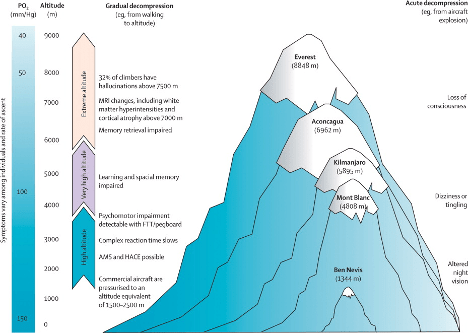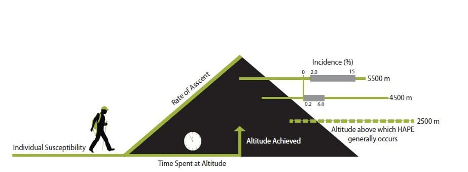
High-altitude pulmonary edema (HAPE) is a life-threatening accumulation of fluid in the lungs that occurs in healthy people used to living at low altitudes who travel above 2,500 meters (8,200 ft). However, cases have also been reported between (1,500–2,500 m.) or (4,900–8,200 ft.) in more vulnerable people. HAPE remains the major cause of death related to high-altitude exposure.
Before HAPE was understood it was commonly confused with pneumonia which resulted in inappropriate treatment. The first documented case of pulmonary edema, confirmed by autopsy, was probably that of Dr. Jacottet who died in 1891 on Mont Blanc.

The inciting factor of HAPE is the decrease in the partial pressure of arterial oxygen caused by the lower air pressure at high altitudes. HAPE generally develops in the first 2 to 4 days of hiking at altitudes >2,500 meters (8,200 ft), and symptoms seem to worsen most commonly on the second night. The most reliable sign an individual is experiencing this is severe fatigue or exercise intolerance, shortness of breath, coughing, chest tightness or congestion, blue skin color, rapid breathing, heart rate, and swelling of the brain can occur are some symptoms they may exhibit.

The primary recommendation for the prevention of HAPE is a gradual ascent. The most studied and preferred medication for the prevention of HAPE is nifedipine which should be used with warming techniques, rest, supplemental oxygen, or portable hyperbaric chambers if available. It is recommended that those who go to high altitudes avoid alcohol or sleeping medication when ascending to high altitudes.
The Wilderness Medical Society recommends that, above 3,000 meters (9,800 ft), climbers
- not increase the sleeping elevation by more than 500 meters (1,600 ft) a day, and
- include a rest day every 3–4 days